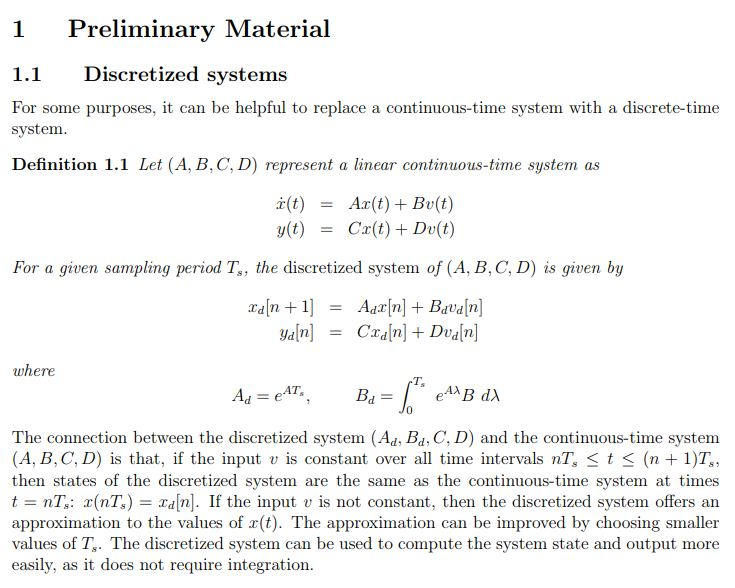Answered step by step
Verified Expert Solution
Question
1 Approved Answer
NOTE: DO Q1, Q2, REFERENCE: The matlab script file mydlsim.m :- % Testing file for Question 1, Assignment 3, 2018. clear all close all A




NOTE: DO Q1, Q2,
REFERENCE:
The matlab script file mydlsim.m :-
% Testing file for Question 1, Assignment 3, 2018. clear all close all A = [-.6 1; 0 0.2 ]; B = [1 ;0 ]; C = [1 0 ]; D = 3;
x0 = [ -1 -1]' ; tfin = 50 T = [0:tfin]; v= cos(T/10); tic [Y,T,X] = mydlsim(A,B,C,D,v,T,x0); mydlsim_runtime = toc
tic [Y1,X1] = dlsim(A,B,C,D,v,x0) ; figure(2) T1 = [0:length(v)-1]; stem(T1,Y1,'r') xlabel('n') ylabel('y[n] using dlsim') dlsim_runtime= toc
1 Preliminary Material 1.1 Discretized systems For some purposes, it can be helpful to replace a continuous-time system with a discrete-time system Definition 1.1 Let (A, B, C, D) represent a linear continuous-time system as (t) = A2(t)+Bu(t) y(t) - Ca(t) D(t) For a given sampling period Ts, the discretized system of (A, B,C, D) is given by where Ts de-4T 0 The connection between the discretized system (Ad, Bd, C, D) and the continuous-time system (A, B, C, D) is that, if the input v is constant over all time intervals nT, t (n 1)T, then states of the discretized system are the same as the continuous-time system at times t = nT,: x(nT,) = xd[n]. If the input u is not constant, then the discretized system offers an approximation to the values of r(t). The approximation can be improved by choosing smaller values of T,. The discretized system can be used to compute the system state and output more easily, as it does not require integration 1 Preliminary Material 1.1 Discretized systems For some purposes, it can be helpful to replace a continuous-time system with a discrete-time system Definition 1.1 Let (A, B, C, D) represent a linear continuous-time system as (t) = A2(t)+Bu(t) y(t) - Ca(t) D(t) For a given sampling period Ts, the discretized system of (A, B,C, D) is given by where Ts de-4T 0 The connection between the discretized system (Ad, Bd, C, D) and the continuous-time system (A, B, C, D) is that, if the input v is constant over all time intervals nT, t (n 1)T, then states of the discretized system are the same as the continuous-time system at times t = nT,: x(nT,) = xd[n]. If the input u is not constant, then the discretized system offers an approximation to the values of r(t). The approximation can be improved by choosing smaller values of T,. The discretized system can be used to compute the system state and output more easily, as it does not require integration
Step by Step Solution
There are 3 Steps involved in it
Step: 1

Get Instant Access to Expert-Tailored Solutions
See step-by-step solutions with expert insights and AI powered tools for academic success
Step: 2

Step: 3

Ace Your Homework with AI
Get the answers you need in no time with our AI-driven, step-by-step assistance
Get Started


